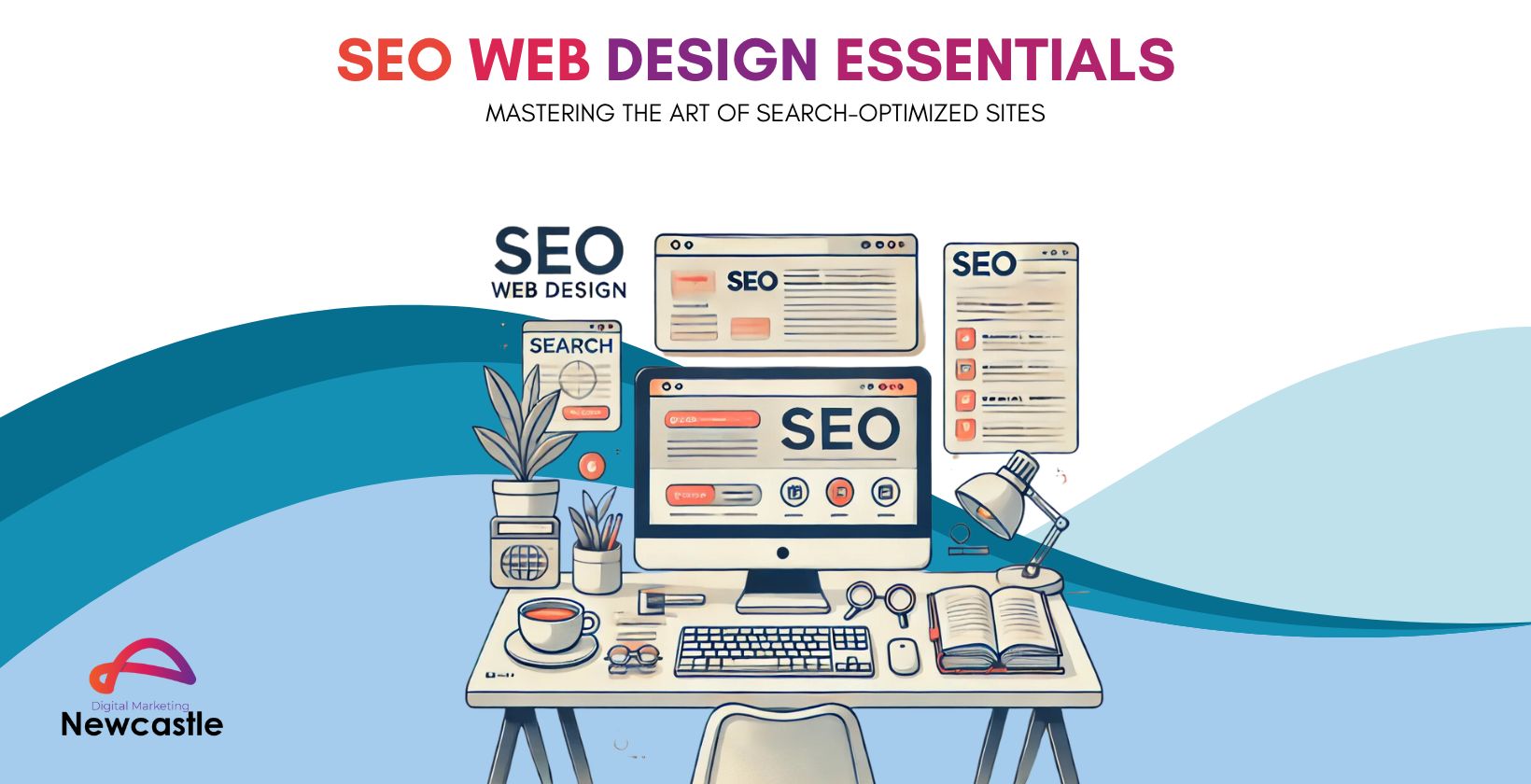In the fast-paced online business world, having a website that stands out is essential.
This is where SEO web design becomes essential. But what is SEO web design, and why is it so important?
We will explore the core components of building a search-optimised website, from keyword research to fast loading speeds, and highlight the common mistakes to avoid, such as keyword stuffing and duplicate content.
You’ll also learn about the importance of responsive design, high-quality content, and proper use of header tags.
Finally, discover how choosing the right team for your SEO web design needs can make all the difference.
This guide will equip you with the knowledge to enhance your website’s performance and achieve online success.
What is SEO Web Design?
SEO Web Design integrates Search Engine Optimization principles with web design practices. This approach creates a visually appealing site optimised for search engines like Google, Bing, and Yahoo, enhancing online presence, visibility, and user experience.
By combining these elements, websites are attractive and easy to find and navigate, boosting their overall effectiveness. This leads us to the importance of SEO web design and its critical role in achieving higher rankings and better performance.
Why is SEO Web Design Important?
SEO Web Design directly impacts a website’s search rankings, driving organic traffic and providing a competitive edge. By effectively integrating SEO Web Design, a website becomes visually appealing and optimised for search engines.
This includes strategic keyword placement, meta tags, and high-quality content that search engine crawlers can easily index. Implementing best practices like mobile responsiveness, fast loading speeds, and user-friendly navigation helps websites achieve higher search engine rankings.
Attracting organic traffic through SEO-friendly web design reduces reliance on paid advertising, making it cost-effective. SEO professionals contribute by researching keywords, implementing on-page and off-page techniques, and monitoring metrics to improve search visibility. With these fundamentals in place, it’s essential to understand the steps to build a fully optimised website for search engines.
How to Create a Search-Optimised Website?
Creating a search-optimised website involves a strategic approach that encompasses the following:
- Thorough keyword research
- Optimising the website’s structure and navigation
- Ensuring fast loading speeds
- Implementing a responsive design for mobile-first indexing
- Producing high-quality content
Research and Choose Relevant Keywords
Researching and choosing relevant keywords is fundamental to SEO as it helps understand what terms users are searching for, which can be efficiently done using tools like Ranktracker.
This process involves delving deep into the specific niche or industry to find words or phrases with high search volume but low competition. Using Rank Tracker or similar tools, one can gather data on the performance of various keywords, such as search volume, keyword difficulty, and potential traffic. It’s important to balance keyword relevance and search volume to attract the right audience and improve search engine visibility.
Optimise Website Structure and Navigation
Optimising website structure and navigation is essential for search engines and user experience (UX) and can be effectively managed using XML Sitemaps.
Enhancing a website’s structure and navigation requires creating a well-organised layout that is intuitive and user-friendly. By implementing XML Sitemaps, web admins can provide search engines with a roadmap of their site’s pages, ensuring that all relevant content is indexed efficiently. This helps boost visibility in search engine results and enhances the overall user experience by enabling visitors to navigate the website seamlessly.
Ensure Fast Loading Speed
Ensuring fast loading speed is important as it directly affects user experience and search results, with search engines preferring quicker websites.
Optimising images to enhance website loading speed is vital to reduce file sizes without compromising quality.
Another effective method is minifying CSS and JavaScript files to decrease the volume of code that needs to be loaded.
Using a content delivery network (CDN) can also help distribute website resources across different servers globally, reducing loading times for users in various regions.
Regularly testing website speed using tools like Google PageSpeed Insights or GTmetrix lets you pinpoint performance bottlenecks and make necessary adjustments.
Use Responsive Design for Mobile Optimization
Responsive design is essential for mobile optimization, especially with the growing importance of mobile-first indexing by search engines like Google.
Responsive design allows websites to adapt and provide an optimal viewing experience across various devices, whether desktops, smartphones, or tablets. This approach ensures that the website remains user-friendly and visually appealing regardless of the screen size or resolution. For instance, a responsive design might adjust the layout of a webpage’s content to fit neatly on a smaller smartphone screen without sacrificing readability or functionality.
Regarding SEO, the rise of mobile-first indexing means that Google primarily uses the mobile version of a site’s content to determine its ranking in search results. Therefore, responsive design is important for maintaining a strong online presence and improving search engine visibility. Websites prioritising mobile optimisation through responsive design are more likely to rank higher in search engine results pages (SERPs) and attract a larger audience.
Create High-Quality and Relevant Content
Creating high-quality and relevant content is the cornerstone of SEO. It attracts both search engines and users, enhancing search rankings and engagement.
One key tip for creating quality SEO content is to conduct thorough keyword research to understand what users are searching for. Incorporating these keywords naturally into your content can increase visibility and relevance.
Structuring your content with headings, bullet points, and images can improve readability and user experience. Utilising internal and external links to reputable sources also signals your content’s credibility to search engines. Examples of effective content strategies include creating informative blog posts, engaging videos, and interactive infographics.
Optimise Images and Videos
Optimising images and videos are key in SEO, as it enhances loading speed and makes content more discoverable. Effective strategies include compressing files to reduce size without losing quality, using alternative text for accessibility and search engine understanding, and naming files descriptively for better indexing.
These practices improve SEO rankings and enhance your site’s user experience. With these techniques in place, it is essential to evaluate the key features of SEO web design to boost your site’s performance further.
What are the Key Elements of SEO Web Design?
The key elements of SEO Web Design include:
- Title tags
- Meta descriptions
- Header tags
- Alt text for images
- URL structure
- Internal and external linking
These play an important role in optimising a website for search engines and improving its visibility.
Title Tags and Meta Descriptions
Title tags and meta descriptions are critical on-page SEO aspects that help search engines understand a webpage’s content and influence click-through rates.
Both title tags and meta descriptions play a vital role in determining how a webpage appears in search engine results pages. While title tags are displayed as the clickable headline in the search results, meta descriptions provide a brief snippet of information about the content. Creating compelling and keyword-rich title tags can greatly improve a page’s visibility and relevance for specific search queries.
Similarly, well-created meta descriptions can entice users to click on the link by providing a concise summary that answers their query. Incorporating relevant keywords in title tags and meta descriptions can increase the likelihood of your page ranking higher in search results.
Header Tags
Header tags (H1, H2, H3, etc.) help structure content and signal to search engines the hierarchy and relevance of information on a webpage.
When utilised effectively, header tags enhance SEO performance and overall user experience. Using appropriate header tags can help search engines understand your content’s main topics and subtopics, making it easier for them to index and rank your page accurately.
It’s essential to ensure that your header tags reflect the content’s structure logically and chronologically, guiding search engines and readers through the page seamlessly.
Alt Text for Images
Alt text for images is essential for SEO as it helps search engines understand the content of images, improving image search rankings and accessibility.
When writing alt text, it is important to be descriptive and concise, summarising the image accurately. Incorporating relevant keywords in the alt text can boost the image’s visibility in search engine results.
By providing informative alt text, website owners cater to search engine algorithms and visually impaired users who rely on screen readers to access web content. Alt text serves as an alternative to images, ensuring that all users can comprehend the visual elements on a page.
URL Structure
A well-optimised URL structure is important for SEO, as it helps search engines and users understand a website’s content and hierarchy.
Having a clear and logical URL hierarchy can greatly improve the chances of search engines properly crawling and indexing your site. When URLs contain well-structured relevant keywords, they can enhance the overall user experience by giving users insight into the content they can expect on a particular page.
Including descriptive keywords in URLs can also help increase the click-through rate from search engine results pages, boosting organic traffic to your site.
Internal and External Linking
Internal and external linking are key to SEO. They aid search engines in understanding page relationships, distributing link equity, and boosting website authority through backlinks.
Backlinks are important for building a website’s credibility. When reputable sites link back to your content, it signals to search engines that your website is trustworthy, enhancing search rankings and visibility.
Focusing on high-quality content naturally attracts links, and fostering connections with influencers and industry experts can yield valuable backlinks. As you work on these strategies, you must know potential pitfalls that could undermine your SEO efforts.
What are the Common Mistakes to Avoid in SEO Web Design?
Common mistakes in SEO Web Design include keyword stuffing, duplicated content, lack of mobile optimisation, slow loading speeds, and poor user experience, all of which can negatively impact search engine rankings and user engagement.
Keyword Stuffing
Keyword stuffing is an outdated SEO practice that overloads a web page with keywords to manipulate search engine rankings.
While it may have been effective in the early days of optimisation, search engines like Google have evolved to penalise sites that engage in keyword stuffing.
This is because artificially inflating keyword density can lead to a poor user experience, as the content becomes unreadable and less valuable to the audience.
Instead of resorting to keyword stuffing, a more effective strategy is to create high-quality, relevant content that naturally incorporates keywords in a way that makes sense to the reader.
Duplicate Content
Duplicate content refers to identical or very similar content appearing on multiple webpages, which can confuse search engines and dilute page rankings.
This can be detrimental to a website’s SEO efforts as search engines may need help determining which version of the content is the original or most relevant. As a result, the search engine might not prioritise any duplicate pages in SERPs, leading to lower visibility and organic traffic.
It is essential for website owners to regularly audit their content to identify any instances of duplication and implement strategies to resolve these issues. One effective approach is to use canonical tags to indicate the preferred version of the content to search engines.
Creating unique and valuable content is key to improving SEO performance and avoiding duplicate content problems. By generating fresh, engaging material that offers a unique perspective or provides additional insights, websites can attract more organic traffic and enhance their search engine rankings.
Lack of Mobile Optimization
Lack of mobile optimisation can severely affect SEO rankings, especially with the prevalence of mobile-first indexing by search engines like Google.
In today’s digital field, where mobile devices have become the primary internet access, ensuring your website is mobile-friendly is paramount for successful search engine optimization. With mobile-first indexing becoming the norm, search engines prioritise the mobile version of websites for ranking and indexing, making it essential to prioritise mobile optimisation.
To enhance mobile usability and improve SEO performance, consider implementing responsive web design that seamlessly adjusts to different screen sizes. Optimise images and videos for quick loading on mobile devices and prioritise legible fonts and concise content for easier consumption.
Focus on improving site speed for mobile users. Faster loading times not only enhance user experience but also contribute positively to SEO rankings. Conduct regular mobile testing to identify and rectify any usability issues to ensure a seamless browsing experience across all devices.
Slow Loading Speed
Slow loading speeds negatively impact SEO and user experience, as search engines favour faster websites, and users are likely to abandon slow-loading pages.
When a website takes too long to load, it can lead to a drop in search engine rankings, affecting organic visibility and traffic. This is because search engines prioritise sites that offer a seamless browsing experience, which includes fast loading times.
Users need more patience for slow-loading pages and quickly bounce off to a competitor’s site if they encounter delays. This high bounce rate hurts conversions and sends a negative signal to search engines, further impacting your SEO efforts.
Poor User Experience
Poor user experience can drive high bounce rates and low engagement, which harms SEO and search engine rankings. Users who need help using a website or finding relevant information will likely leave quickly, causing high bounce rates.
If the content is subpar or not user-friendly, visitors may not stay, leading to low engagement. These factors send negative signals to search engines, affecting the site’s ranking.
Enhancing user experience means improving website design for usability, streamlining navigation for better findability, and creating high-quality content that meets user expectations.
This is why it’s important to choose a service that understands web design and excels in SEO. Our approach to optimising websites for search engines sets us apart.
Why Choose Us for Your SEO Web Design Needs: How Do We Optimise Websites for Search Engines?
Choosing us for your SEO web design needs means partnering with a team of seasoned SEO experts and web designers who utilise proven methods and advanced analytics to boost your website’s search engine performance and enhance your ROI.
Our team stays ahead by analysing the latest search engine algorithms and trends. We prioritise user experience in all design aspects, making your site appealing and easy to navigate for both search engines and visitors.
Through keyword research and competitor analysis, we create content and design components that draw the right audience and increase organic traffic. This comprehensive approach ensures your site is visible and impactful, setting the stage for online success.
Wrapping Up: Why SEO Web Design Is Key to Online Success
In conclusion, SEO Web Design is fundamental to achieving online success. It enhances visibility, drives organic traffic, and ensures a positive user experience, positioning your website to thrive in a competitive digital field.
By integrating SEO with web design, you improve your search engine rankings and create a seamless user journey. The synergy between SEO and web design results in faster loading times, mobile responsiveness, and clear navigation, all of which contribute to higher user engagement and conversion rates.
Furthermore, SEO Web Design fosters trust with search engines, making it easier for your target audience to find your website amidst the vast online clutter. Proper optimisation makes your site more accessible and appealing to both users and search engine algorithms, leading to increased brand visibility and credibility.





